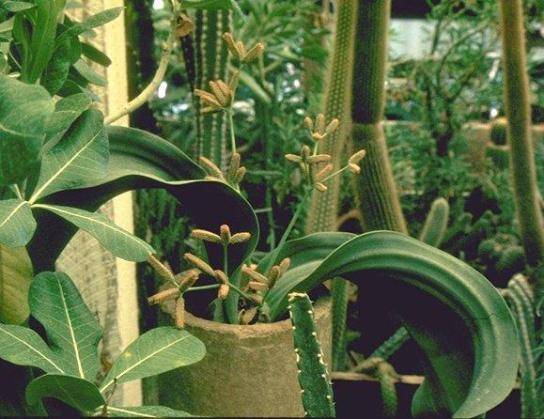Welwitschia mirabilis Seeds (RARE)
Family: Welwitschiaceae (welwitschia family)
Common names: welwitschia, tumboa, n'tumbo (Angolan), tweeblaarkanniedood (Afr.)

Description
An adult welwitschia consists of two leaves, a stem base and roots. That is all! Its two permanent leaves are unique in the plant kingdom. They are the original leaves from when the plant was a seedling, and they just continue to grow and are never shed. They are leathery, broad, strap-shaped and they lie on the ground becoming torn to ribbons and tattered with age. The stem is low, woody, hollowed-out, obconical in shape and sturdy. It grows to about 500 mm in height. The largest recorded specimen is in the Messum Mountains and is 1.8 m high, and another on the Welwitschia Flats near the Swakop River is 1.2 m tall and 8.7 m wide. Carbon dating tells us that on average, welwitschias are 500-600 years old, although some of the larger specimens are thought to be 2000 years old. Their estimated lifespan is 400 to 1500 years. Growth occurs annually during the summer months. Welwitschia is thought to be a relic from the Jurassic period when gymnosperms dominated the world's flora, its ancestor trapped in an environment that slowly but progressively became more arid, and all its close relatives long since disappeared.

Distribution
Welwitschia mirabilis grows in isolated communities in the Namib Desert, in a narrow strip, about 1 000 km along up the coast from the Kuiseb River in central Namibia to Mossamedes in southern Angola. The plants are seldom found more than 100 to 150 km from the coast, and their distribution coincides with the fog belt.
Uses & cultural aspects
The core, especially of the female plant, was used as food for people in earlier times. It is said to be very tasty either raw or baked in hot ashes, is is how it got its Herero name, onyanga, which means onion of the desert.
You're buying a pack of 10 Seeds of this easy to grow, amazing, rare & interesting plant. Click Here to see other pack sizes available.
FREE "How to Grow Welwitschia mirabilis" Guide included


